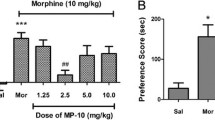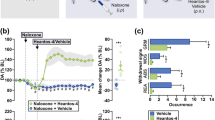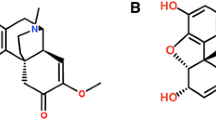Abstract
Rationale and objectives
We have recently reported that conditioned morphine reward and tolerance to its antinociceptive effect, but not expression of morphine dependence, were attenuated by 2-(phosphonomethyl)pentanedioic acid (2-PMPA), a prototypic inhibitor of glutamate carboxipeptidase II (GCP II), which is an enzyme responsible for the supply of glutamate. In the present study, we investigated in more detail the effects of GCP II inhibition on opioid dependence and tolerance to its antinociceptive effect in C57/Bl mice using a novel GCP II inhibitor.
Results
The treatment with 2-(3-mercaptopropyl)pentanedioic acid (2-MPPA; 60 but not 10 or 30 mg/kg) prevented the development of morphine tolerance without affecting acute morphine antinociception. 2-MPPA at 30 and 60 mg/kg did not prevent the development of dependence induced by 10 and 30 mg/kg of morphine. The study on opioid withdrawal syndrome, i.e., expression of opioid dependence, demonstrated that 2-MPPA potentiated jumping behavior and teeth chattering but attenuated chewing and ptosis. None of these opioid withdrawal signs were affected by 2-MPPA in morphine nondependent mice. Pretreatment with the mGluR II antagonist LY341495 (1 mg/kg) reversed the 2-MPPA-induced increase or decrease in opioid withdrawal signs in morphine-dependent mice. 2-MPPA (60 mg/kg) administered for 7 days with morphine did not affect brain concentration of this opiate.
Conclusions
The present findings suggest complex effects of GCP II inhibition on morphine dependence and tolerance and imply a role of mGluR II in the actions of 2-MPPA.





Similar content being viewed by others
References
Akaoka H, Aston-Jones G (1991) Opiate withdrawal-induced hyperactivity of locus coeruleus neurons is substantially mediated by augmented excitatory amino acid input. J Neurosci 11:3830–3839
Akaoka H, Aston-Jones G (1993) Indirect serotonergic agonists attenuate neuronal opiate withdrawal. Neuroscience 54:561–565
Blasig J, Herz A, Reinhold K, Zieglgansberger S (1973) Development of physical dependence on morphine in respect to time and dosage and quantification of the precipitated withdrawal syndrome in rats. Psychopharmacologia 33:19–38
Bohn LM, Gainetdinov RR, Lin FT, Lefkowitz RJ, Caron MG (2000) mu-Opioid receptor desensitization by beta-arrestin-2 determines morphine tolerance but not dependence. Nature 408:720–723
Burlina AP, Skaper SD, Mazza MR, Ferrari V, Leon A, Burlina AB (1994) N-acetylaspartylglutamate selectively inhibits neuronal responses to N-methyl-D-aspartic acid in vitro. J Neurochem 63:1174–1177
Calvino B, Lagowska J, Ben-Ari Y (1979) Morphine withdrawal syndrome: differential participation of structures located within the amygdaloid complex and striatum of the rat. Brain Res 177:19–34
Cartmell J, Monn JA, Schoepp DD (1999) The metabotropic glutamate 2/3 receptor agonists LY354740 and LY379268 selectively attenuate phencyclidine versus d-amphetamine motor behaviors in rats. J Pharmacol Exp Ther 291:161–170
Dewey WL, Harris LS (1975) The tail flick test. In: Ehrenpreis S, Neidle A (eds) Methods in narcotic research. Marcel Dekker, New York, pp 101–109
Dzoljic ED, Kaplan CD, Dzoljic MR (1988) Effect of ibogaine on naloxone precipitated withdrawal syndrome in chronic morphine dependent rats. Arch Int Pharmacodyn Ther 294:64–70
Fundytus ME, Coderre TJ (1994) Effect of activity at metabotropic, as well as ionotropic (NMDA), glutamate receptors on morphine dependence. Br J Pharmacol 113:1215–1220
Fundytus ME, Coderre TJ (1997) Attenuation of precipitated morphine withdrawal symptoms by acute i.c.v. administration of a group II mGluR agonist. Br J Pharmacol 121:511–514
Glare PA (1991) A simple, rapid method for the simultaneous determination of morphine and its principal metabolites in plasma using high-performance liquid chromatography and fluorometric detection. Ther Drug Monit 13:226–232
Hamdy MM, Noda Y, Miyazaki M, Mamiya T, Nozaki A, Nitta A, Sayed M, Assi AA, Gomaa A, Nabeshima T (2004) Molecular mechanisms in dizocilpine–induced attenuation of development of morphine dependence: an association with cortical Ca2+/calmodulin-dependent signal cascade. Behav Brain Res 152:263–270
Jhamandas KH, Marsala M, Ibuki T, Yaksh TL (1996) Spinal amino acid release and precipitated withdrawal in rats chronically infused with spinal morphine. J Neurosci 16:2758–2766
Kawashima N, Karasawa J, Shimazaki T, Chaki S, Okuyama S, Yasuhara A, Nakazato A (2005) Neuropharmacological profiles of antagonists of group II metabotropic glutamate receptors. Neurosci Lett 378:131–134
Kingston AE, Ornstein PL, Wright RA, Johnson BG, Mayne NG, Burnett JP, Belagaje R, Wu S, Schoepp DD (1998) LY341495 is a nanomolar potent and selective antagonist of group II metabotropic glutamate receptors. Neuropharmacology 37:1–12
Klodzinska A, Chojnacka Wojcik E, Palucha A, Branski P, Popik P, Pilc A (1999) Potential anti-anxiety and anti-addictive effects of LY 354740, a selective group II glutamate metabotropic receptors agonist in animal models. Neuropharmacology 38:1831–1839
Koyuncuoglu H, Dizdar Y, Ariciogly F, Sayin U (1992) Effects of MK-801 on morphine physical dependence: attenuation and intensification. Pharmacol Biochem Behav 43:487–490
Kozela E, Pilc A, Popik P (2003) Inhibitory effects of MPEP, an mGluR5 antagonist, and memantine, an N-methyl-D-aspartate receptor antagonist, on morphine antinociceptive tolerance in mice. Psychopharmacology 165:245–251
Kupfenberg H (1964) A sensitive fluorometric assay for morphine in plasma and brain. J Pharmacol Exp Ther 145:247–251
Majer P, Jackson PF, Delahanty G, Grella BS, Ko YS, Li W, Liu Q, Maclin KM, Polakova J, Shaffer KA, Stoermer D, Vitharana D, Wang EY, Zakrzewski A, Rojas C, Slusher BS, Wozniak KM, Burak E, Limsakun T, Tsukamoto T (2003) Synthesis and biological evaluation of thiol-based inhibitors of glutamate carboxypeptidase II: discovery of an orally active GCP II inhibitor. J Med Chem 46:1989–1996
Maldonado R, Stinus L, Gold LH, Koob GF (1992) Role of different brain structures in the expression of the physical morphine withdrawal syndrome. J Pharmacol Exp Ther 261:669–677
Mclemore GL, Kest B, Inturrisi CE (1997) The effects of LY293558, an AMPA receptor antagonist, on acute and chronic morphine dependence. Brain Res 778:120–126
Neale JH, Bzdega T, Wroblewska B (2000) N-Acetylaspartylglutamate: the most abundant peptide neurotransmitter in the mammalian central nervous system. J Neurochem 75:443–452
Olszewski RT, Bukhari N, Zhou J, Kozikowski AP, Wroblewski JT, Shamimi-Noori S, Wroblewska B, Bzdega T, Vicini S, Barton FB, Neale JH (2004) NAAG peptidase inhibition reduces locomotor activity and some stereotypes in the PCP model of schizophrenia via group II mGluR. J Neurochem 89:876–885
Palucha A, Branski P, Pilc A (2004) Selective mGlu5 receptor antagonist MTEP attenuates naloxone-induced morphine withdrawal symptoms. Pol J Pharmacol 56:863–866
Popik P, Skolnick P (1996) The NMDA antagonist memantine blocks the expression and maintenance of morphine dependence. Pharmacol Biochem Behav 53:791–798
Popik P, Kozela E, Danysz W (2000a) Clinically available NMDA receptor antagonists memantine and dextromethorphan reverse existing tolerance to the antinociceptive effects of morphine in mice. Naunyn-Schmiedeberg's Arch Pharmacol 361:425–432
Popik P, Kozela E, Pilc A (2000b) Selective agonist of group II glutamate metabotropic receptors, LY354740, inhibits tolerance to analgesic effects of morphine in mice. Br J Pharmacol 130:1425–1431
Popik P, Kozela E, Wrobel M, Wozniak KM, Slusher BS (2003) Morphine tolerance and reward but not expression of morphine dependence are inhibited by the selective glutamate carboxypeptidase II (GCP II, NAALADase) inhibitor, 2-PMPA. Neuropsychopharmacology 28:457–467
Rasmussen K, Aghajanian GK (1989) Withdrawal induced activation of locus coeruleus neurons in opiate dependent rats: attenuation by lesions of the nucleus paragigantocellularis. Brain Res 505:346–350
Rasmussen K, Fuller RW, Stockton ME, Perry KW, Swinford RM, Ornstein PL (1991) NMDA receptor antagonists supress behaviors but not norepinephrine turnover or locus coeruleus unit activity induced by opiate withdrawal. Eur J Pharmacol 197:9–16
Rasmussen K, Hsu MA, Vandergriff J (2004) The selective mGlu2/3 receptor antagonist LY341495 exacerbates behavioral signs of morphine withdrawal and morphine-withdrawal-induced activation of locus coeruleus neurons. Neuropharmacology 46:620–628
Robinson MB, Blakely RD, Couto R, Coyle JT (1987) Hydrolysis of the brain dipeptide N-acetyl-L-aspartyl-L-glutamate. Identification and characterization of a novel N-acetylated alpha-linked acidic dipeptidase activity from rat brain. J Biol Chem 262:14498–14506
Rojas C, Thomas AG, Majer P, Tsukamoto T, Lu XM, Vornov JJ, Wozniak KM, Slusher BS (2003) Glutamate carboxypeptidase II inhibition as a novel therapeutic target. Adv Exp Med Biol 524:205–213
Sanabria ER, Wozniak KM, Slusher BS, Keller A (2004) GCP II (NAALADase) inhibition suppresses mossy fiber-CA3 synaptic neurotransmission by a presynaptic mechanism. J Neurophysiol 91:182–193
Slusher BS, Vornov JJ, Thomas AG, Hurn PD, Harukuni I, Bhardwaj A, Traystman RJ, Robinson MB, Britton P, Lu XC, Tortella FC, Wozniak KM, Yudkoff M, Potter BM, Jackson PF (1999) Selective inhibition of NAALADase, which converts NAAG to glutamate, reduces ischemic brain injury. Nat Med 5:1396–1402
Stinus L, Le Moal M, Koob GF (1990) Nucleus accumbens and amygdala are possible substrates for the aversive stimulus effects of opiate withdrawal. Neuroscience 37:767–773
Tamaru Y, Nomura S, Mizuno N, Shigemoto R (2001) Distribution of metabotropic glutamate receptor mGluR3 in the mouse CNS: differential location relative to pre- and postsynaptic sites. Neuroscience 106:481–503
Trujillo KA, Akil H (1991) Inhibition of morphine tolerance and dependence by the NMDA receptor antagonist MK-801. Science 251:85–87
Westbrook GL, Mayer ML, Namboodiri MA, Neale JH (1986) High concentrations of N-acetylaspartylglutamate (NAAG) selectively activate NMDA receptors on mouse spinal cord neurons in cell culture. J Neurosci 6:3385–3392
Wroblewska B, Wroblewski JT, Pshenichkin S, Surin A, Sullivan SE, Neale JH (1997) N-acetylaspartylglutamate selectively activates mGluR3 receptors in transfected cells. J Neurochem 69:174–181
Yamamoto T, Hirasawa S, Wroblewska B, Grajkowska E, Zhou J, Kozikowski A, Wroblewski J, Neale JH (2004) Antinociceptive effects of N-acetylaspartylglutamate (NAAG) peptidase inhibitors ZJ-11, ZJ-17 and ZJ-43 in the rat formalin test and in the rat neuropathic pain model. Eur J Neurosci 20:483–494
Zarrindast MR, Mousa-Ahmadi E (1999) Effects of GABAergic system on naloxone-induced jumping in morphine-dependent mice. Eur J Pharmacol 381:129–133
Zhao J, Ramadan E, Cappiello M, Wroblewska B, Bzdega T, Neale JH (2001) NAAG inhibits KCl-induced [(3)H]-GABA release via mGluR3, cAMP, PKA and L-type calcium conductance. Eur J Neurosci 13:340–346
Acknowledgements
Supported in part by KBN PBZ 033/P05/2001 grant and statutory funds of the Institute of Pharmacology, Polish Academy of Sciences, Krakow. The authors wish to thank Mrs. Radoslawa Wrobel for the linguistic corrections.
Author information
Authors and Affiliations
Corresponding author
Rights and permissions
About this article
Cite this article
Kozela, E., Wrobel, M., Kos, T. et al. 2-MPPA, a selective glutamate carboxypeptidase II inhibitor, attenuates morphine tolerance but not dependence in C57/Bl mice. Psychopharmacology 183, 275–284 (2005). https://doi.org/10.1007/s00213-005-0182-5
Received:
Accepted:
Published:
Issue Date:
DOI: https://doi.org/10.1007/s00213-005-0182-5




